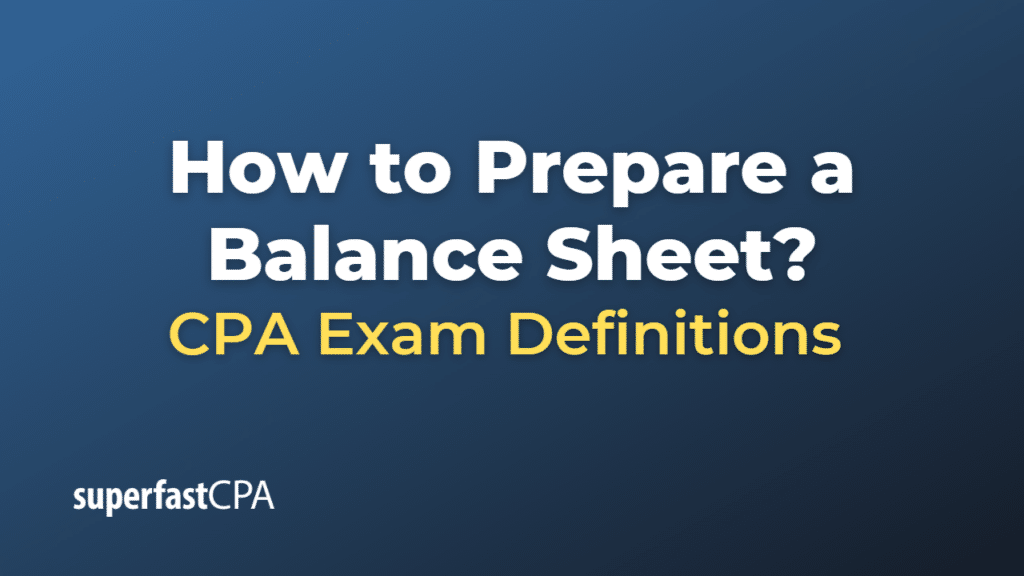How to Prepare a Balance Sheet
A balance sheet is one of the key financial statements prepared by a company. It provides a snapshot of the company’s financial condition at a specific point in time by showing what it owns (assets), what it owes (liabilities), and the net worth (shareholders’ equity). Here’s a step-by-step guide on how to prepare a balance sheet:
- Header: At the top of the balance sheet, you should include the name of the company, the title of the report (Balance Sheet), and the date to which the report applies.
- Assets: List all the company’s assets, which are items of value that the company owns. Assets are typically divided into current assets (cash, accounts receivable, inventory, and other assets expected to be converted to cash or used up within one year) and non-current assets (property, plant and equipment, and other long-term investments). The total assets represent the sum of current and non-current assets.
- Liabilities: Next, list all the company’s liabilities, which are obligations the company owes to others. Like assets, liabilities are also divided into current liabilities (accounts payable, wages payable, and other obligations due within one year) and non-current liabilities (long-term debts, deferred tax liabilities, and other obligations due in more than one year). The total liabilities represent the sum of current and non-current liabilities.
- Shareholders’ Equity: This represents the net worth of the company. It’s the amount that would be left if all assets were sold and all liabilities were paid. Equity is calculated as total assets minus total liabilities. It’s usually broken down into common stock, retained earnings, and other components depending on the company’s structure.
- Balancing the Balance Sheet: Confirm that your balance sheet is in balance. The fundamental concept of a balance sheet is that Assets = Liabilities + Equity. If your total assets do not equal the sum of your total liabilities and total equity, then there’s an error that needs to be corrected.
- Review and Finalize: Review the balance sheet for any errors or omissions. Make sure all numbers are accurate, all necessary accounts are included, and all calculations are correct.
Remember, while a balance sheet provides valuable information about a company’s financial position at a specific point in time, it’s most useful when reviewed in the context of historical trends and compared with balance sheets of other companies in the same industry.
Example of How to Prepare a Balance Sheet
Let’s consider a simplified balance sheet for a hypothetical company “XYZ Corp.” as of December 31, 2023:
XYZ Corp. Balance Sheet As of December 31, 2023
ASSETS Current Assets:
- Cash: $20,000
- Accounts Receivable: $15,000
- Inventory: $25,000
Total Current Assets: $60,000
Non-Current Assets:
- Property, Plant, and Equipment: $100,000
- Long-Term Investments: $40,000
Total Non-Current Assets: $140,000
Total Assets: $200,000
LIABILITIES Current Liabilities:
- Accounts Payable: $10,000
- Wages Payable: $5,000
Total Current Liabilities: $15,000
Non-Current Liabilities:
- Long-Term Debt: $35,000
Total Non-Current Liabilities: $35,000
Total Liabilities: $50,000
SHAREHOLDERS’ EQUITY
- Common Stock: $100,000
- Retained Earnings: $50,000
Total Shareholders’ Equity: $150,000
Total Liabilities and Shareholders’ Equity: $200,000
As you can see, the balance sheet is in balance with total assets of $200,000 equal to the sum of total liabilities and shareholders’ equity of $200,000 (i.e., $50,000 + $150,000). The balance sheet provides a snapshot of XYZ Corp.’s financial position as of December 31, 2023, showing what it owns, what it owes, and the net ownership interest in the company’s assets.













